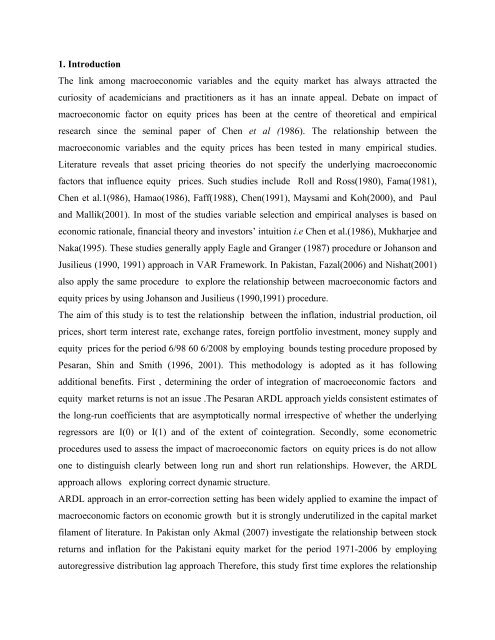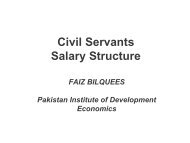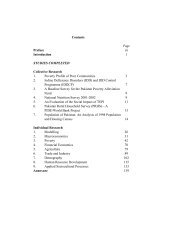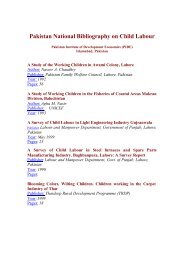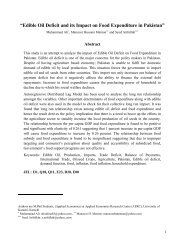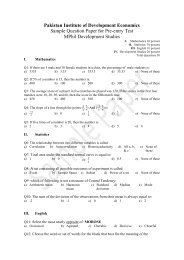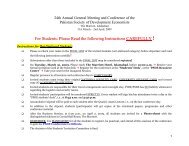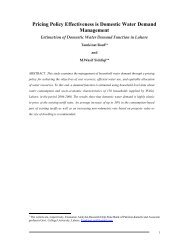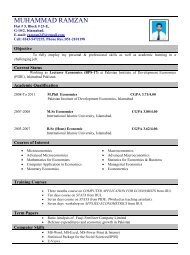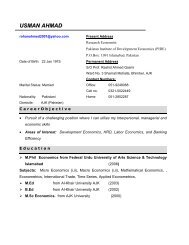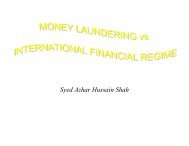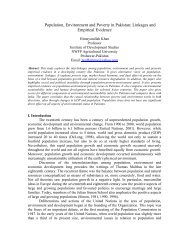Macroeconomic Factors and Equity Prices - Pakistan Institute of ...
Macroeconomic Factors and Equity Prices - Pakistan Institute of ...
Macroeconomic Factors and Equity Prices - Pakistan Institute of ...
You also want an ePaper? Increase the reach of your titles
YUMPU automatically turns print PDFs into web optimized ePapers that Google loves.
1. Introduction<br />
The link among macroeconomic variables <strong>and</strong> the equity market has always attracted the<br />
curiosity <strong>of</strong> academicians <strong>and</strong> practitioners as it has an innate appeal. Debate on impact <strong>of</strong><br />
macroeconomic factor on equity prices has been at the centre <strong>of</strong> theoretical <strong>and</strong> empirical<br />
research since the seminal paper <strong>of</strong> Chen et al (1986). The relationship between the<br />
macroeconomic variables <strong>and</strong> the equity prices has been tested in many empirical studies.<br />
Literature reveals that asset pricing theories do not specify the underlying macroeconomic<br />
factors that influence equity prices. Such studies include Roll <strong>and</strong> Ross(1980), Fama(1981),<br />
Chen et al.1(986), Hamao(1986), Faff(1988), Chen(1991), Maysami <strong>and</strong> Koh(2000), <strong>and</strong> Paul<br />
<strong>and</strong> Mallik(2001). In most <strong>of</strong> the studies variable selection <strong>and</strong> empirical analyses is based on<br />
economic rationale, financial theory <strong>and</strong> investors’ intuition i.e Chen et al.(1986), Mukharjee <strong>and</strong><br />
Naka(1995). These studies generally apply Eagle <strong>and</strong> Granger (1987) procedure or Johanson <strong>and</strong><br />
Jusilieus (1990, 1991) approach in VAR Framework. In <strong>Pakistan</strong>, Fazal(2006) <strong>and</strong> Nishat(2001)<br />
also apply the same procedure to explore the relationship between macroeconomic factors <strong>and</strong><br />
equity prices by using Johanson <strong>and</strong> Jusilieus (1990,1991) procedure.<br />
The aim <strong>of</strong> this study is to test the relationship between the inflation, industrial production, oil<br />
prices, short term interest rate, exchange rates, foreign portfolio investment, money supply <strong>and</strong><br />
equity prices for the period 6/98 60 6/2008 by employing bounds testing procedure proposed by<br />
Pesaran, Shin <strong>and</strong> Smith (1996, 2001). This methodology is adopted as it has following<br />
additional benefits. First , determining the order <strong>of</strong> integration <strong>of</strong> macroeconomic factors <strong>and</strong><br />
equity market returns is not an issue .The Pesaran ARDL approach yields consistent estimates <strong>of</strong><br />
the long-run coefficients that are asymptotically normal irrespective <strong>of</strong> whether the underlying<br />
regressors are I(0) or I(1) <strong>and</strong> <strong>of</strong> the extent <strong>of</strong> cointegration. Secondly, some econometric<br />
procedures used to assess the impact <strong>of</strong> macroeconomic factors on equity prices is do not allow<br />
one to distinguish clearly between long run <strong>and</strong> short run relationships. However, the ARDL<br />
approach allows exploring correct dynamic structure.<br />
ARDL approach in an error-correction setting has been widely applied to examine the impact <strong>of</strong><br />
macroeconomic factors on economic growth but it is strongly underutilized in the capital market<br />
filament <strong>of</strong> literature. In <strong>Pakistan</strong> only Akmal (2007) investigate the relationship between stock<br />
returns <strong>and</strong> inflation for the <strong>Pakistan</strong>i equity market for the period 1971-2006 by employing<br />
autoregressive distribution lag approach Therefore, this study first time explores the relationship


